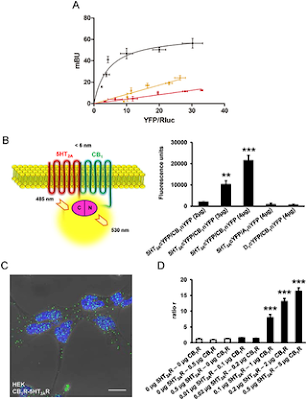What we are learning.
I have reported here Medical Marijuana research and its therapeutic value for treating pain. The specifics posts feature publications that reference use of our
Pain and Inflammation Research Markers. These include:
J. Desroches, J.-F. Bouchard, L. Gendron, P. Beaulieu. Involvement of cannabinoid receptors in peripheral and spinal morphine analgesia ☆ Neuroscience, Volume 261, 7 March 2014, Pages 23–42.http://dx.doi.org/10.1016/j.neuroscience.2013.12.030.
Iryna A. Khasabova,Sergey Khasabov, Justin Paz, Catherine Harding-Rose, Donald A. Simone, and Virginia S. Seybold. Cannabinoid Type-1 Receptor Reduces Pain and Neurotoxicity Produced by Chemotherapy. The Journal of Neuroscience, 16 May 2012, 32(20): 7091-7101; doi: 10.1523/JNEUROSCI.0403-12.2012
Here researchers study the impact of Marijuana on memory impairment using our one of our
5-HT Serotonin Antibodies:
Xavier Viñals, Estefanía Moreno, Laurence Lanfumey, Arnau Cordomí, Antoni Pastor, Rafael de La Torre, Paola Gasperini, Gemma Navarro, Lesley A. Howell, Leonardo Pardo, Carmen Lluís, Enric I. Canela, Peter J. McCormick, Rafael Maldonado, Patricia Robledo. Cognitive Impairment Induced by Delta9-tetrahydrocannabinol Occurs through Heteromers between Cannabinoid CB1 and Serotonin 5-HT2A Receptors. Published: July 9, 2015DOI: 10.1371/journal.pbio.1002194.
Impact on Memory: Activation of cannabinoid CB1 receptors (CB1R) by delta9-tetrahydrocannabinol (THC) produces a variety of negative effects with major consequences in cannabis users that constitute important drawbacks for the use of cannabinoids as therapeutic agents. For this reason, there is a tremendous medical interest in harnessing the beneficial effects of THC. Behavioral studies carried out in mice lacking 5-HT2A receptors (5-HT2AR) revealed a remarkable 5-HT2AR-dependent dissociation in the beneficial antinociceptive effects of THC and its detrimental amnesic properties We found that specific effects of THC such as memory deficits, anxiolytic-like effects, and social interaction are under the control of 5-HT2AR, but its acute hypolocomotor, hypothermic, anxiogenic, and antinociceptive effects are not. In biochemical studies, we show that CB1R and 5-HT2AR form heteromers that are expressed and functionally active in specific brain regions involved in memory impairment. Remarkably, our functional data shows that costimulation of both receptors by agonists reduces cell signaling, antagonist binding to one receptor blocks signaling of the interacting receptor, and heteromer formation leads to a switch in G-protein coupling for 5-HT2AR from Gq to Gi proteins. Synthetic peptides with the sequence of transmembrane helices 5 and 6 of CB1R, fused to a cell-penetrating peptide, were able to disrupt receptor heteromerization in vivo, leading to a selective abrogation of memory impairments caused by exposure to THC. These data reveal a novel molecular mechanism for the functional interaction between CB1R and 5-HT2AR mediating cognitive impairment. CB1R-5-HT2AR heteromers are thus good targets to dissociate the cognitive deficits induced by THC from its beneficial antinociceptive properties.

Figures: 5-HT2AR and CB1R form heteromers in transfected cells.
In (A), BRET saturation experiments were performed in HEK-293T cells transfected with 0.025 μg of 5-HT2AR-Rluc cDNA and increasing amounts of CB1R-YFP cDNA (0.05 μg to 1.5 μg, black curve), with 0.5 μg of dopamine D1R-Rluc cDNA and increasing amounts of CB1R-YFP cDNA (0.5 μg to 6 μg, yellow line), or with 0.025 μg of 5-HT2AR-Rluc cDNA and increasing amounts of adenosine A1R-YFP cDNA (0.05 μg to 1.5 μg, red line). The relative amount of BRET is given as a function of 100 x the ratio between the fluorescence of the acceptor (YFP) and the luciferase activity of the donor (Rluc). BRET is expressed as milli BRET units (mBU) and is given as the mean ± standard deviation (SD) of 3–6 experiments grouped as a function of the amount of BRET acceptor. In (B), a schematic representation of fluorescence complementation experiments is depicted in the left panel showing that fluorescence only appears after the YFP Venus hemiprotein complementation due to the proximity of two receptors fused to hemi-YFP Venus proteins (cYFP or nYFP). In the right panel, fluorescence at 530 nm was detected in HEK-293T cells transfected with different amounts of cDNA corresponding to both 5-HT2AR-cYFP and CB1R-nYFP (equal amount for each construct), but not in negative controls in which cells were transfected with cDNA corresponding to 5-HT2AR-cYFP and the noninteracting adenosine A1 receptor-nYFP or CB1R-nYFP and the noninteracting dopamine D1 receptor-cYFP. One-way ANOVA followed by a Dunnett’s multiple comparison test showed a significant fluorescence over basal values in HEK-293T cells (** p< 0.01, *** p< 0.001). In (C), PLAs were performed in HEK-293T cells expressing CB1R and 5-HT2AR. Confocal microscopy images (superimposed sections) are shown in which heteromers appear as green spots. In all cases, cell nuclei were stained with DAPI (blue). Scale bars = 20 μm. In (D), PLAs were performed in nontransfected HEK-293T cells, cells transiently transfected with 0.5 μg of CB1R or 5-HT2AR cDNA (negative controls, white columns), or with increasing amounts of CB1R and 5-HT2AR cDNA (black columns). In each case, the ratio between the number of green spots and the number of cells showing spots (ratio r) was calculated. One-way ANOVA followed by a Dunnett’s multiple comparison test showed a significant PLA staining over nontranfected cells (*** p <; 0.001).
doi:10.1371/journal.pbio.1002194.g004
Yes, memory impairment must be considered as a side effect of Medical Marijuana, I am confident there are human subjects that would volunteer for cognition studies to get a clearer picture of the short and long term impact on users.







